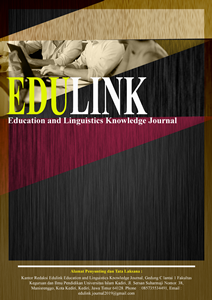How Scaffolding Concept is Realised Through The Use of Feedback: A Sociocultural Perspective
Abstract
The aim of this paper is to discuss how the metaphor of scaffolding is realised through the use of feedback in an ESL class in the US. In doing the analysis, I look at three types of feedback (self-feedback, peer feedback, and teacher feedback) and how each type help to shape the learning process in the learning context which is discussed. A number of experimental researches indicate that L2 learners would benefit from corrective feedback -regardless of the type of the feedback (Alfaajreh and Lantolf, 1994; Caroll and Swain, 1992). In the same vein, from this learning context, it can be concluded that each type of feedback can potentially serve as a mediation tool to scaffold students’ learning process.
References
Allen, D. andKatayama, A.(2016). Relative second language proficiency andthe givingand receiving of written peer feedback.System,56, pp.96-106.Bickhard, M.H.(2005). Functional scaffolding and self-scaffolding.New Ideas in Psychology, 23(3), pp.166-173.
Carroll, S., Swain, M. and Roberge, Y. (1992). The role of feedback inadult secondlanguage acquisition: Error correction and morphological generalizations.AppliedPsycholinguistics,13(2), pp.173-198.
Caroll, S. and Swain, M.(1993). Explicit and implicit negative feedback: An empiricalstudy of the learning of linguistic generalization.Studies in Second Language Acquisition,15, pp.357-386.De Guerrero, M. and Villamil, O.S..(2000). Activating the ZPD: Mutual scaffolding in L2peer revision.The Modern Language Journal,84(1), pp.51-68.
Donato, R.(1998). Collective scaffolding in second language learning. In Lantolf, J.P andAppel, G. (Eds).Vygotskian approaches to second language research. New Jersey: Ablex Publishing Company. Ch 2.
Donato, R. and McCormick, D.,(1994). A sociocultural perspective on language learningstrategies: The role of mediation.The Modern Language Journal,78(4), pp.453-464.
Ellis, R(2012).Language teaching research and language pedagogy. West Sussex: JohnWiley & Sons.
Fernández,M., Wegerif, R., Mercer, N. and Rojas-Drummond, S. (2015). Re-conceptualizing" scaffolding" and the zone of proximal development in the context ofsymmetrical collaborative learning.The Journal of Classroom Interaction, pp.54-72.
Foster, P. and Ohta, A.S.(2005). Negotiation for meaning and peer assistance in secondlanguageclassrooms.Applied Linguistics,26(3), pp.402-430.
Gibbons, P.(2003). Mediating language learning: Teacher interactions with ESL studentsin a contentâ€based classroom.Tesol Quarterly,37(2), pp.247-273.
Granott, N.(2005). Scaffolding dynamically towardchange: Previous and newperspectives.New Ideas in Psychology,23(3), pp.140-151
Kozulin, A.(2003). Psychological tools and mediated learning. In Kozulin, A., Gindis, B.,Ageyev, V.S. and Miller, S.M.,Vygotsky’s educational theory in cultural context. 2003.pp.15-38.
Kozulin, A., Gindis, B., Ageyev, V.S. and Miller, S.M.(2003). Introduction: Socioculturaltheory and education: Students, teachers, and knowledge.Vygotsky’s educational theory incultural context, pp.1-14.
Lantolf, J.P. and Appel, G.(1994).Vygotskian approaches to second language research.London: Greenwood Publishing Group.
Mascolo, M.F. (2005). Change processes in development: The concept of coactivescaffolding.New Ideas in Psychology,23(3), pp.185-196.
Ohta, A.S.(1995). Applying Sociocultural Theory to an Analysis of Learner Discourse:Learner-Learner Collaborative Interaction in the Zone of Proximal Development.Issues inApplied linguistics,6(2), pp.93-121.
Pritchard, A.(2013).Ways of learning: Learning theories and learning styles in theclassroom. London: Routledge.
Sato, M. (2013). Beliefs about peer interaction and peer corrective feedback: Efficacy ofclassroom intervention.The Modern Language Journal,97(3), pp.611-633.
Swain, M., Lapkin, I. Knouzi, W. Suzuki, andBrooksL.(2009) Languaging: universitystudents learn the grammatical concept of voice in French. Modern Language Journal 93:6–30
Knouzi, I., Swain, M., Lapkin, S. and Brooks, L.(2010). Selfâ€scaffolding mediated bylanguaging: microgenetic analysis of high and low performers.International Journal ofApplied Linguistics,20(1), pp.23-49.
Tharp, R.G. and Gallimore, R.(1988). Rousing minds to life.Teaching and learning insocial contexts.Cambridge: Cambridge University Press.
Wells, G.(1999).Dialogic inquiry: Towards a socio-cultural practice and theory ofeducation. MA: Cambridge University Press.
Wertsch, J.V.(2007). Mediation. In Daniels, H. Cole, M. and Wertsch, J.V. (Eds). TheCambridgeCompanion to Vygotsky.Cambridge: Cambridge University Press. Ch. 7.
Wood, D., Bruner, J.S. and Ross, G.(1976). The role of tutoring in problem solving.Journal of child psychology and psychiatry,17(2), pp.89-100.

This work is licensed under a Creative Commons Attribution 4.0 International License.
This work is licensed under a Creative Commons Attribution License























 This work is licensed under a
This work is licensed under a  https://orcid.org/0000-0001-9166-6040
https://orcid.org/0000-0001-9166-6040
